CWRF Early Career Grant: Sleep Duration, Obesity, and Native Children
VerifiedAdded on 2023/06/04
|10
|2314
|130
Report
AI Summary
This research grant proposal explores the relationship between sleep duration and obesity in Australian children, aiming to address the health gap between native and non-native children. The study hypothesizes that inadequate sleep contributes to overweight and obesity due to factors like altered eating schedules and appetite-regulating hormones. The proposed methodology involves a systematic review of literature from 2008-2018, analyzing studies that link sleep duration with weight gain and obesity. Statistical analysis will be conducted using STATA software to estimate the relationship between sleep duration and overweight/obesity. The research intends to identify modifiable risk factors and mechanisms underlying the sleep-weight association to inform public health interventions and improve health outcomes for native Australian children. The budget covers staffing, database access, communication, equipment, training, and publication costs.
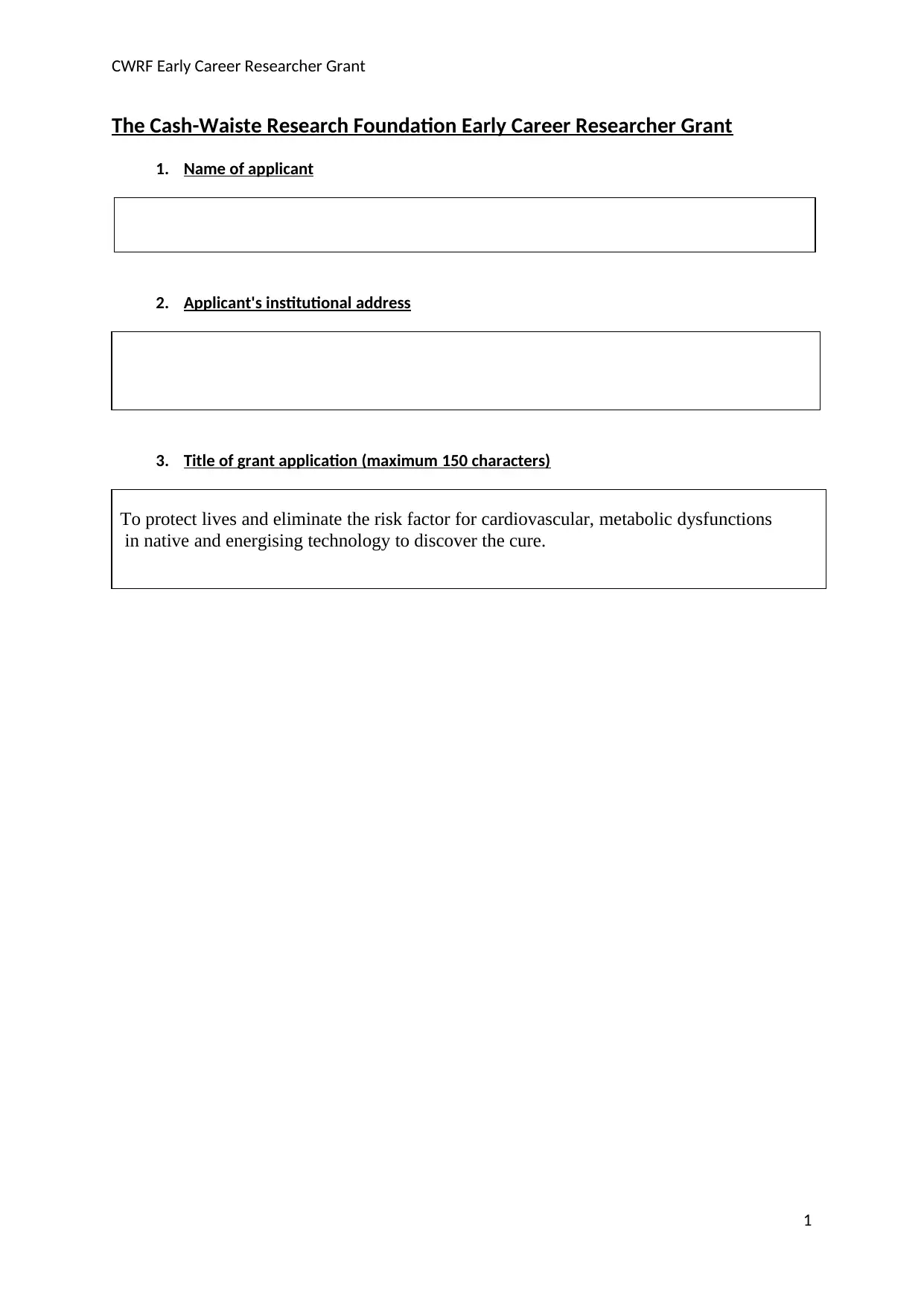
CWRF Early Career Researcher Grant
The Cash-Waiste Research Foundation Early Career Researcher Grant
1. Name of applicant
2. Applicant's institutional address
3. Title of grant application (maximum 150 characters)
To protect lives and eliminate the risk factor for cardiovascular, metabolic dysfunctions
in native and energising technology to discover the cure.
1
The Cash-Waiste Research Foundation Early Career Researcher Grant
1. Name of applicant
2. Applicant's institutional address
3. Title of grant application (maximum 150 characters)
To protect lives and eliminate the risk factor for cardiovascular, metabolic dysfunctions
in native and energising technology to discover the cure.
1
Paraphrase This Document
Need a fresh take? Get an instant paraphrase of this document with our AI Paraphraser
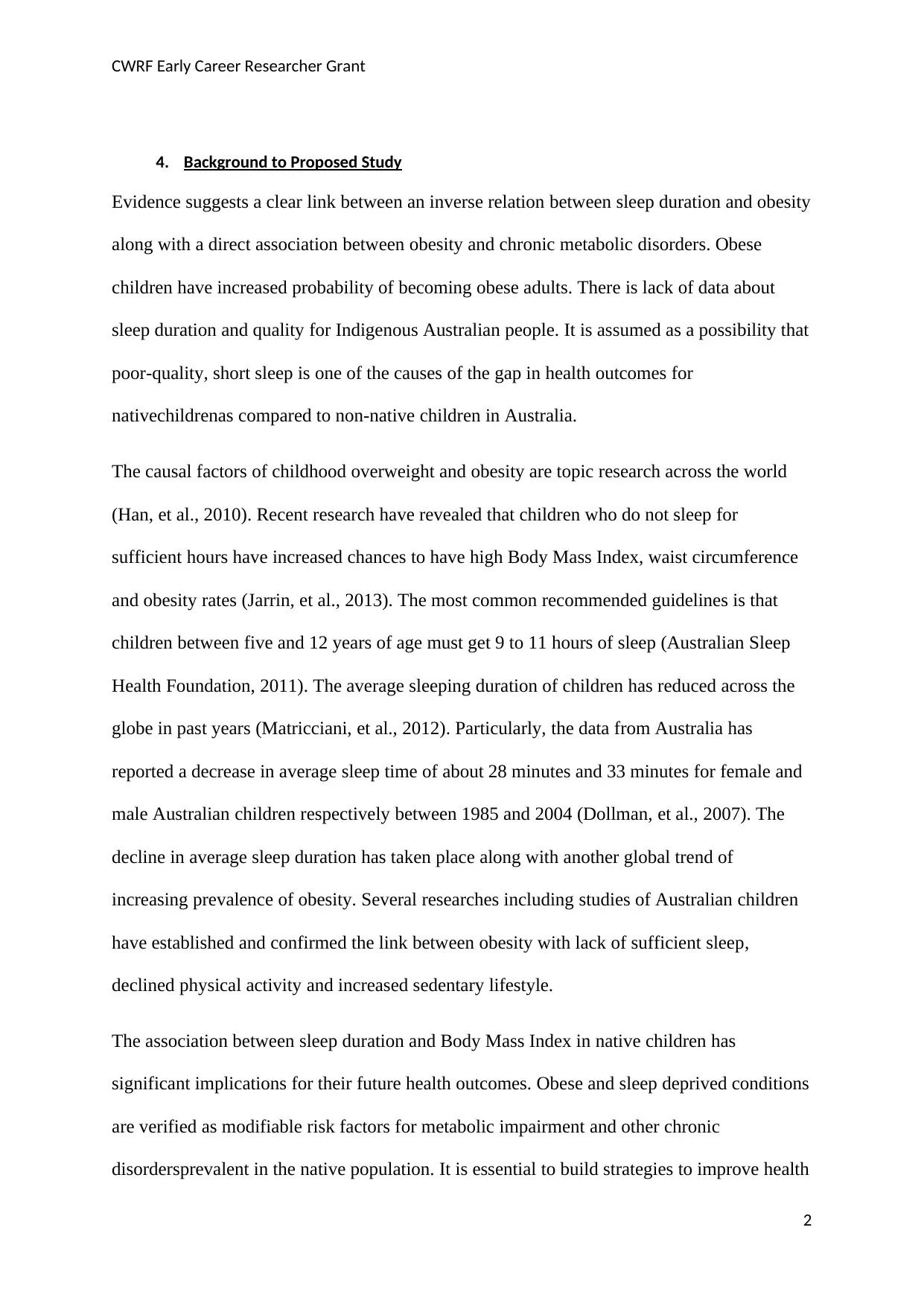
CWRF Early Career Researcher Grant
4. Background to Proposed Study
Evidence suggests a clear link between an inverse relation between sleep duration and obesity
along with a direct association between obesity and chronic metabolic disorders. Obese
children have increased probability of becoming obese adults. There is lack of data about
sleep duration and quality for Indigenous Australian people. It is assumed as a possibility that
poor-quality, short sleep is one of the causes of the gap in health outcomes for
nativechildrenas compared to non-native children in Australia.
The causal factors of childhood overweight and obesity are topic research across the world
(Han, et al., 2010). Recent research have revealed that children who do not sleep for
sufficient hours have increased chances to have high Body Mass Index, waist circumference
and obesity rates (Jarrin, et al., 2013). The most common recommended guidelines is that
children between five and 12 years of age must get 9 to 11 hours of sleep (Australian Sleep
Health Foundation, 2011). The average sleeping duration of children has reduced across the
globe in past years (Matricciani, et al., 2012). Particularly, the data from Australia has
reported a decrease in average sleep time of about 28 minutes and 33 minutes for female and
male Australian children respectively between 1985 and 2004 (Dollman, et al., 2007). The
decline in average sleep duration has taken place along with another global trend of
increasing prevalence of obesity. Several researches including studies of Australian children
have established and confirmed the link between obesity with lack of sufficient sleep,
declined physical activity and increased sedentary lifestyle.
The association between sleep duration and Body Mass Index in native children has
significant implications for their future health outcomes. Obese and sleep deprived conditions
are verified as modifiable risk factors for metabolic impairment and other chronic
disordersprevalent in the native population. It is essential to build strategies to improve health
2
4. Background to Proposed Study
Evidence suggests a clear link between an inverse relation between sleep duration and obesity
along with a direct association between obesity and chronic metabolic disorders. Obese
children have increased probability of becoming obese adults. There is lack of data about
sleep duration and quality for Indigenous Australian people. It is assumed as a possibility that
poor-quality, short sleep is one of the causes of the gap in health outcomes for
nativechildrenas compared to non-native children in Australia.
The causal factors of childhood overweight and obesity are topic research across the world
(Han, et al., 2010). Recent research have revealed that children who do not sleep for
sufficient hours have increased chances to have high Body Mass Index, waist circumference
and obesity rates (Jarrin, et al., 2013). The most common recommended guidelines is that
children between five and 12 years of age must get 9 to 11 hours of sleep (Australian Sleep
Health Foundation, 2011). The average sleeping duration of children has reduced across the
globe in past years (Matricciani, et al., 2012). Particularly, the data from Australia has
reported a decrease in average sleep time of about 28 minutes and 33 minutes for female and
male Australian children respectively between 1985 and 2004 (Dollman, et al., 2007). The
decline in average sleep duration has taken place along with another global trend of
increasing prevalence of obesity. Several researches including studies of Australian children
have established and confirmed the link between obesity with lack of sufficient sleep,
declined physical activity and increased sedentary lifestyle.
The association between sleep duration and Body Mass Index in native children has
significant implications for their future health outcomes. Obese and sleep deprived conditions
are verified as modifiable risk factors for metabolic impairment and other chronic
disordersprevalent in the native population. It is essential to build strategies to improve health
2
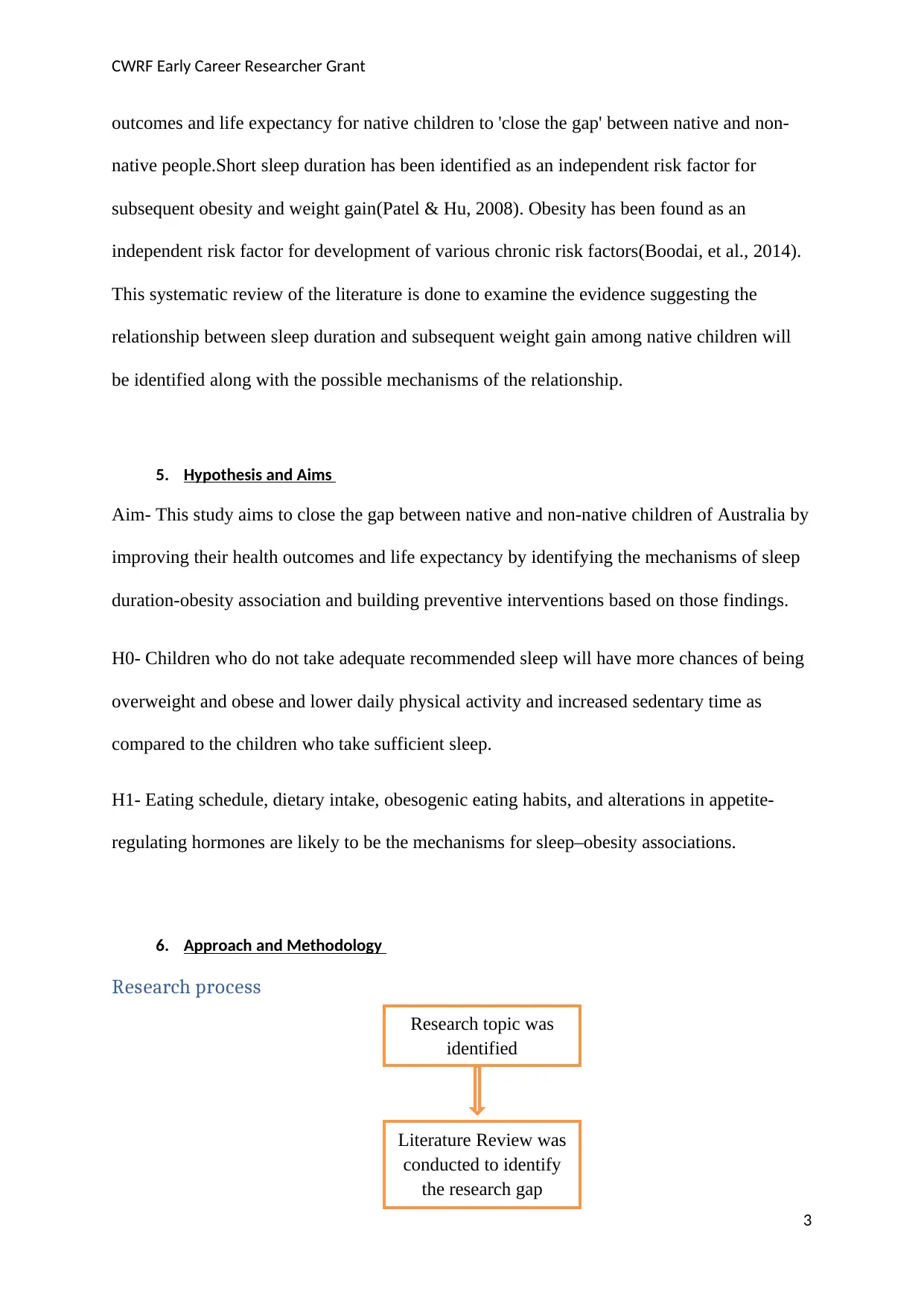
CWRF Early Career Researcher Grant
outcomes and life expectancy for native children to 'close the gap' between native and non-
native people.Short sleep duration has been identified as an independent risk factor for
subsequent obesity and weight gain(Patel & Hu, 2008). Obesity has been found as an
independent risk factor for development of various chronic risk factors(Boodai, et al., 2014).
This systematic review of the literature is done to examine the evidence suggesting the
relationship between sleep duration and subsequent weight gain among native children will
be identified along with the possible mechanisms of the relationship.
5. Hypothesis and Aims
Aim- This study aims to close the gap between native and non-native children of Australia by
improving their health outcomes and life expectancy by identifying the mechanisms of sleep
duration-obesity association and building preventive interventions based on those findings.
H0- Children who do not take adequate recommended sleep will have more chances of being
overweight and obese and lower daily physical activity and increased sedentary time as
compared to the children who take sufficient sleep.
H1- Eating schedule, dietary intake, obesogenic eating habits, and alterations in appetite-
regulating hormones are likely to be the mechanisms for sleep–obesity associations.
6. Approach and Methodology
Research process
3
Research topic was
identified
Literature Review was
conducted to identify
the research gap
outcomes and life expectancy for native children to 'close the gap' between native and non-
native people.Short sleep duration has been identified as an independent risk factor for
subsequent obesity and weight gain(Patel & Hu, 2008). Obesity has been found as an
independent risk factor for development of various chronic risk factors(Boodai, et al., 2014).
This systematic review of the literature is done to examine the evidence suggesting the
relationship between sleep duration and subsequent weight gain among native children will
be identified along with the possible mechanisms of the relationship.
5. Hypothesis and Aims
Aim- This study aims to close the gap between native and non-native children of Australia by
improving their health outcomes and life expectancy by identifying the mechanisms of sleep
duration-obesity association and building preventive interventions based on those findings.
H0- Children who do not take adequate recommended sleep will have more chances of being
overweight and obese and lower daily physical activity and increased sedentary time as
compared to the children who take sufficient sleep.
H1- Eating schedule, dietary intake, obesogenic eating habits, and alterations in appetite-
regulating hormones are likely to be the mechanisms for sleep–obesity associations.
6. Approach and Methodology
Research process
3
Research topic was
identified
Literature Review was
conducted to identify
the research gap
⊘ This is a preview!⊘
Do you want full access?
Subscribe today to unlock all pages.

Trusted by 1+ million students worldwide
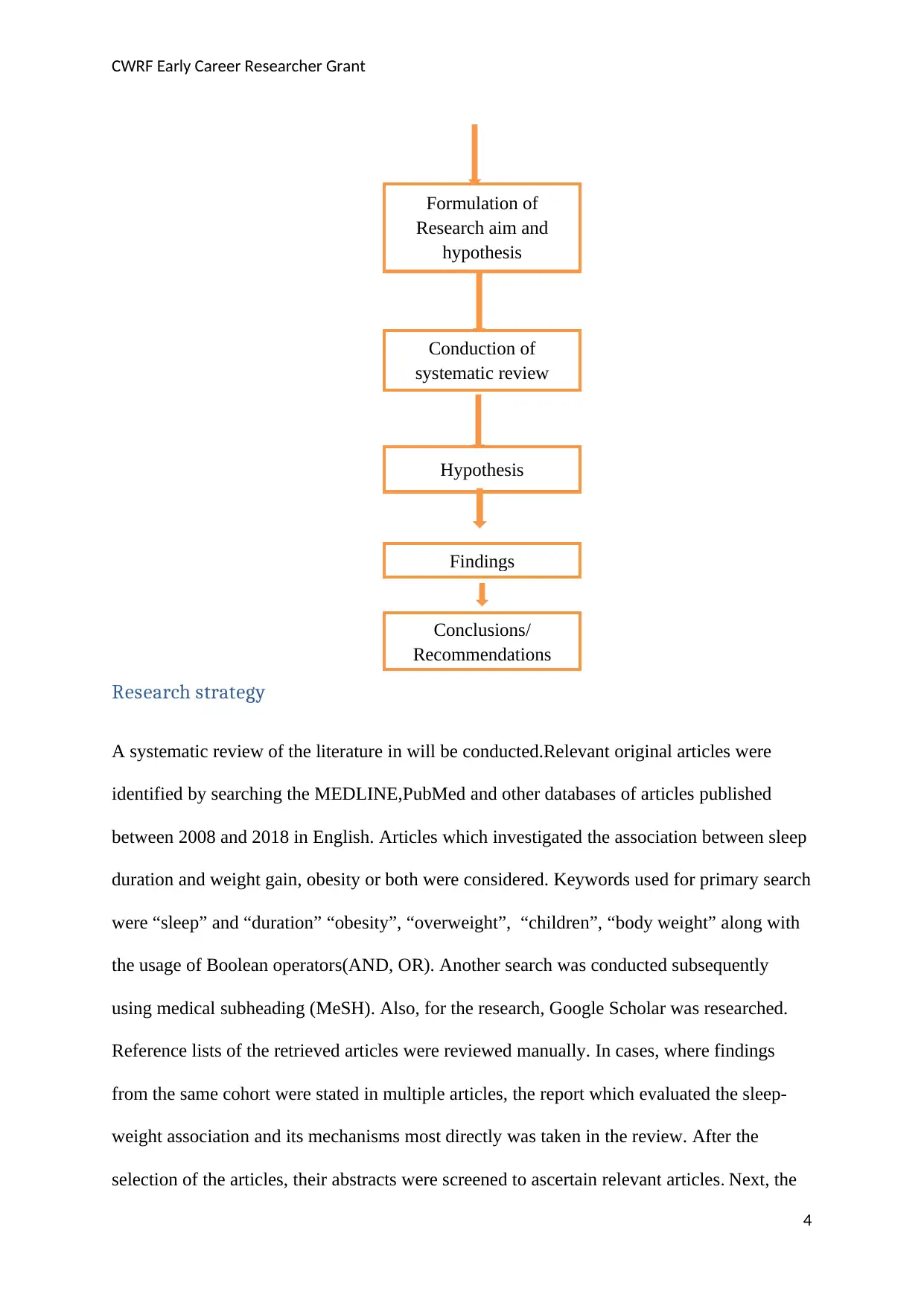
CWRF Early Career Researcher Grant
Research strategy
A systematic review of the literature in will be conducted.Relevant original articles were
identified by searching the MEDLINE,PubMed and other databases of articles published
between 2008 and 2018 in English. Articles which investigated the association between sleep
duration and weight gain, obesity or both were considered. Keywords used for primary search
were “sleep” and “duration” “obesity”, “overweight”, “children”, “body weight” along with
the usage of Boolean operators(AND, OR). Another search was conducted subsequently
using medical subheading (MeSH). Also, for the research, Google Scholar was researched.
Reference lists of the retrieved articles were reviewed manually. In cases, where findings
from the same cohort were stated in multiple articles, the report which evaluated the sleep-
weight association and its mechanisms most directly was taken in the review. After the
selection of the articles, their abstracts were screened to ascertain relevant articles. Next, the
4
Formulation of
Research aim and
hypothesis
Conduction of
systematic review
Hypothesis
Findings
Conclusions/
Recommendations
Research strategy
A systematic review of the literature in will be conducted.Relevant original articles were
identified by searching the MEDLINE,PubMed and other databases of articles published
between 2008 and 2018 in English. Articles which investigated the association between sleep
duration and weight gain, obesity or both were considered. Keywords used for primary search
were “sleep” and “duration” “obesity”, “overweight”, “children”, “body weight” along with
the usage of Boolean operators(AND, OR). Another search was conducted subsequently
using medical subheading (MeSH). Also, for the research, Google Scholar was researched.
Reference lists of the retrieved articles were reviewed manually. In cases, where findings
from the same cohort were stated in multiple articles, the report which evaluated the sleep-
weight association and its mechanisms most directly was taken in the review. After the
selection of the articles, their abstracts were screened to ascertain relevant articles. Next, the
4
Formulation of
Research aim and
hypothesis
Conduction of
systematic review
Hypothesis
Findings
Conclusions/
Recommendations
Paraphrase This Document
Need a fresh take? Get an instant paraphrase of this document with our AI Paraphraser
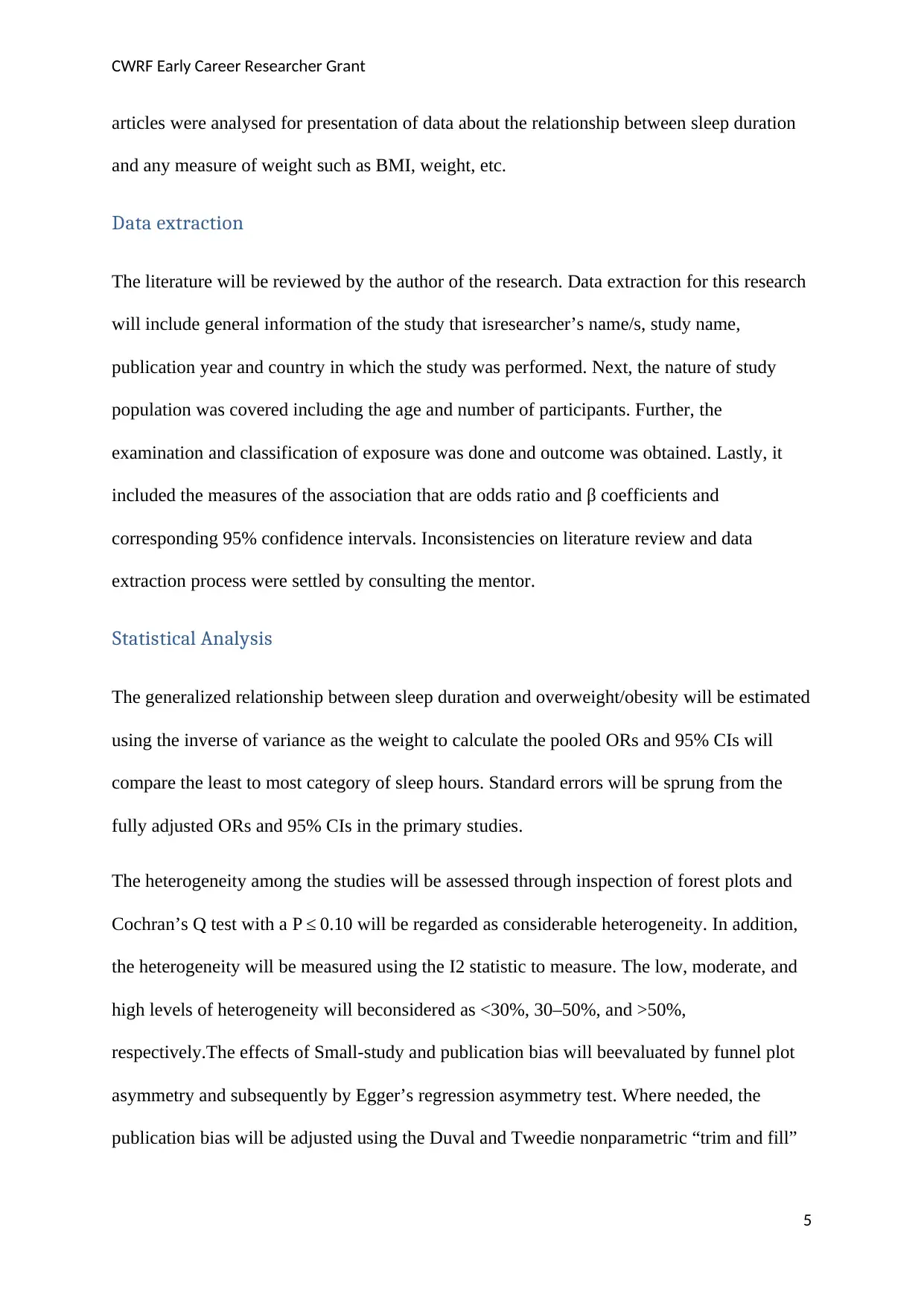
CWRF Early Career Researcher Grant
articles were analysed for presentation of data about the relationship between sleep duration
and any measure of weight such as BMI, weight, etc.
Data extraction
The literature will be reviewed by the author of the research. Data extraction for this research
will include general information of the study that isresearcher’s name/s, study name,
publication year and country in which the study was performed. Next, the nature of study
population was covered including the age and number of participants. Further, the
examination and classification of exposure was done and outcome was obtained. Lastly, it
included the measures of the association that are odds ratio and β coefficients and
corresponding 95% confidence intervals. Inconsistencies on literature review and data
extraction process were settled by consulting the mentor.
Statistical Analysis
The generalized relationship between sleep duration and overweight/obesity will be estimated
using the inverse of variance as the weight to calculate the pooled ORs and 95% CIs will
compare the least to most category of sleep hours. Standard errors will be sprung from the
fully adjusted ORs and 95% CIs in the primary studies.
The heterogeneity among the studies will be assessed through inspection of forest plots and
Cochran’s Q test with a P ≤ 0.10 will be regarded as considerable heterogeneity. In addition,
the heterogeneity will be measured using the I2 statistic to measure. The low, moderate, and
high levels of heterogeneity will beconsidered as <30%, 30–50%, and >50%,
respectively.The effects of Small-study and publication bias will beevaluated by funnel plot
asymmetry and subsequently by Egger’s regression asymmetry test. Where needed, the
publication bias will be adjusted using the Duval and Tweedie nonparametric “trim and fill”
5
articles were analysed for presentation of data about the relationship between sleep duration
and any measure of weight such as BMI, weight, etc.
Data extraction
The literature will be reviewed by the author of the research. Data extraction for this research
will include general information of the study that isresearcher’s name/s, study name,
publication year and country in which the study was performed. Next, the nature of study
population was covered including the age and number of participants. Further, the
examination and classification of exposure was done and outcome was obtained. Lastly, it
included the measures of the association that are odds ratio and β coefficients and
corresponding 95% confidence intervals. Inconsistencies on literature review and data
extraction process were settled by consulting the mentor.
Statistical Analysis
The generalized relationship between sleep duration and overweight/obesity will be estimated
using the inverse of variance as the weight to calculate the pooled ORs and 95% CIs will
compare the least to most category of sleep hours. Standard errors will be sprung from the
fully adjusted ORs and 95% CIs in the primary studies.
The heterogeneity among the studies will be assessed through inspection of forest plots and
Cochran’s Q test with a P ≤ 0.10 will be regarded as considerable heterogeneity. In addition,
the heterogeneity will be measured using the I2 statistic to measure. The low, moderate, and
high levels of heterogeneity will beconsidered as <30%, 30–50%, and >50%,
respectively.The effects of Small-study and publication bias will beevaluated by funnel plot
asymmetry and subsequently by Egger’s regression asymmetry test. Where needed, the
publication bias will be adjusted using the Duval and Tweedie nonparametric “trim and fill”
5
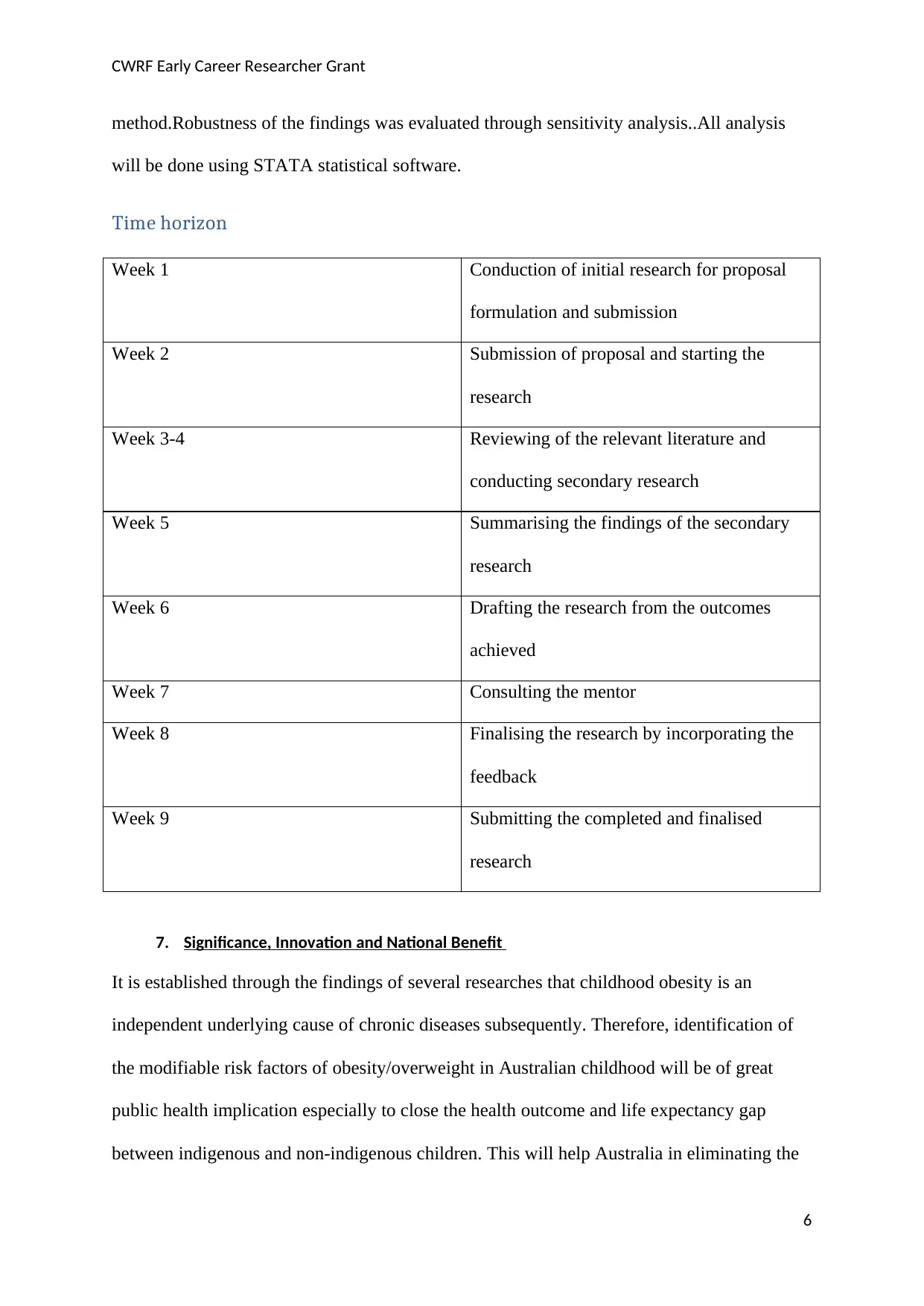
CWRF Early Career Researcher Grant
method.Robustness of the findings was evaluated through sensitivity analysis..All analysis
will be done using STATA statistical software.
Time horizon
Week 1 Conduction of initial research for proposal
formulation and submission
Week 2 Submission of proposal and starting the
research
Week 3-4 Reviewing of the relevant literature and
conducting secondary research
Week 5 Summarising the findings of the secondary
research
Week 6 Drafting the research from the outcomes
achieved
Week 7 Consulting the mentor
Week 8 Finalising the research by incorporating the
feedback
Week 9 Submitting the completed and finalised
research
7. Significance, Innovation and National Benefit
It is established through the findings of several researches that childhood obesity is an
independent underlying cause of chronic diseases subsequently. Therefore, identification of
the modifiable risk factors of obesity/overweight in Australian childhood will be of great
public health implication especially to close the health outcome and life expectancy gap
between indigenous and non-indigenous children. This will help Australia in eliminating the
6
method.Robustness of the findings was evaluated through sensitivity analysis..All analysis
will be done using STATA statistical software.
Time horizon
Week 1 Conduction of initial research for proposal
formulation and submission
Week 2 Submission of proposal and starting the
research
Week 3-4 Reviewing of the relevant literature and
conducting secondary research
Week 5 Summarising the findings of the secondary
research
Week 6 Drafting the research from the outcomes
achieved
Week 7 Consulting the mentor
Week 8 Finalising the research by incorporating the
feedback
Week 9 Submitting the completed and finalised
research
7. Significance, Innovation and National Benefit
It is established through the findings of several researches that childhood obesity is an
independent underlying cause of chronic diseases subsequently. Therefore, identification of
the modifiable risk factors of obesity/overweight in Australian childhood will be of great
public health implication especially to close the health outcome and life expectancy gap
between indigenous and non-indigenous children. This will help Australia in eliminating the
6
⊘ This is a preview!⊘
Do you want full access?
Subscribe today to unlock all pages.

Trusted by 1+ million students worldwide
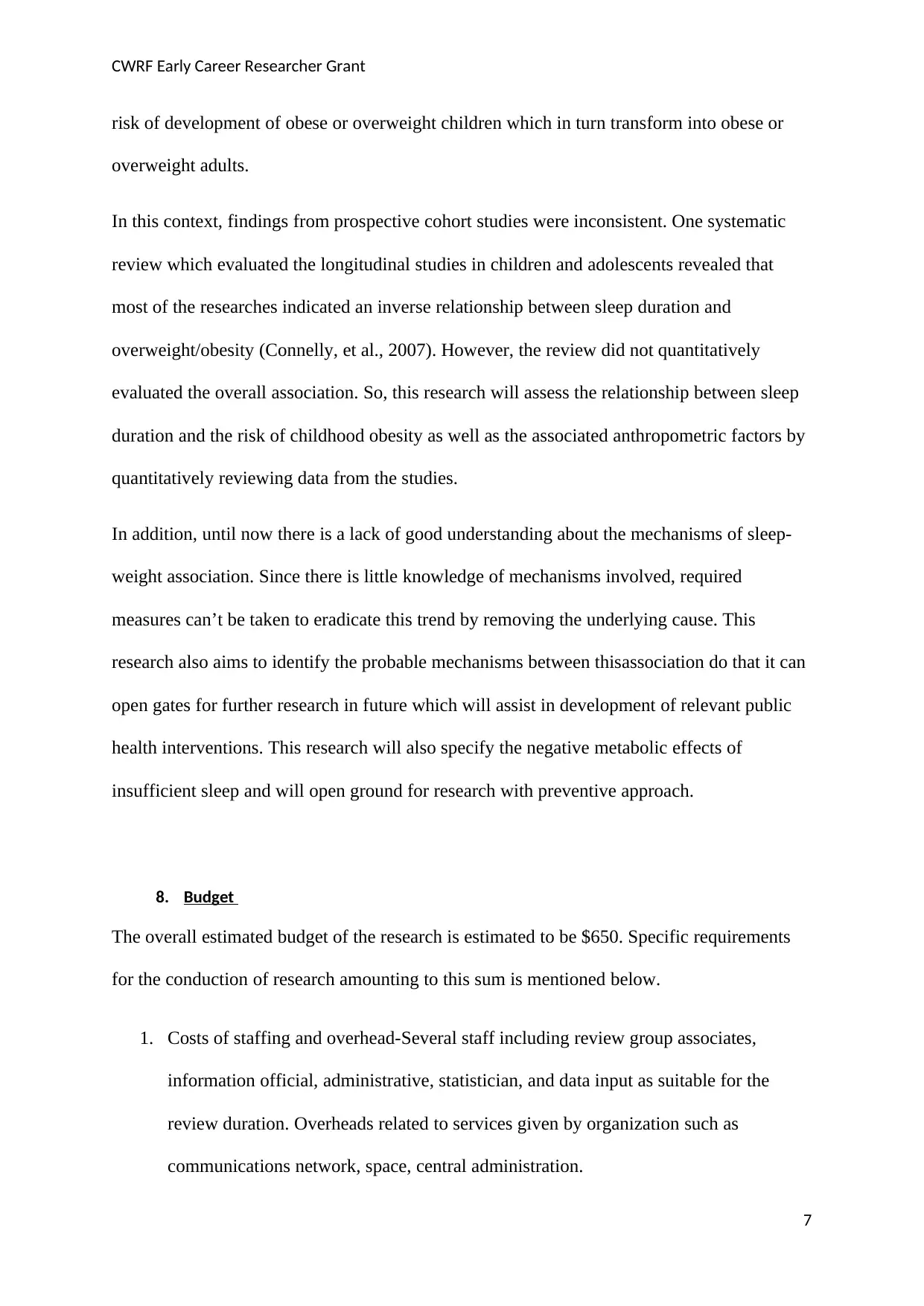
CWRF Early Career Researcher Grant
risk of development of obese or overweight children which in turn transform into obese or
overweight adults.
In this context, findings from prospective cohort studies were inconsistent. One systematic
review which evaluated the longitudinal studies in children and adolescents revealed that
most of the researches indicated an inverse relationship between sleep duration and
overweight/obesity (Connelly, et al., 2007). However, the review did not quantitatively
evaluated the overall association. So, this research will assess the relationship between sleep
duration and the risk of childhood obesity as well as the associated anthropometric factors by
quantitatively reviewing data from the studies.
In addition, until now there is a lack of good understanding about the mechanisms of sleep-
weight association. Since there is little knowledge of mechanisms involved, required
measures can’t be taken to eradicate this trend by removing the underlying cause. This
research also aims to identify the probable mechanisms between thisassociation do that it can
open gates for further research in future which will assist in development of relevant public
health interventions. This research will also specify the negative metabolic effects of
insufficient sleep and will open ground for research with preventive approach.
8. Budget
The overall estimated budget of the research is estimated to be $650. Specific requirements
for the conduction of research amounting to this sum is mentioned below.
1. Costs of staffing and overhead-Several staff including review group associates,
information official, administrative, statistician, and data input as suitable for the
review duration. Overheads related to services given by organization such as
communications network, space, central administration.
7
risk of development of obese or overweight children which in turn transform into obese or
overweight adults.
In this context, findings from prospective cohort studies were inconsistent. One systematic
review which evaluated the longitudinal studies in children and adolescents revealed that
most of the researches indicated an inverse relationship between sleep duration and
overweight/obesity (Connelly, et al., 2007). However, the review did not quantitatively
evaluated the overall association. So, this research will assess the relationship between sleep
duration and the risk of childhood obesity as well as the associated anthropometric factors by
quantitatively reviewing data from the studies.
In addition, until now there is a lack of good understanding about the mechanisms of sleep-
weight association. Since there is little knowledge of mechanisms involved, required
measures can’t be taken to eradicate this trend by removing the underlying cause. This
research also aims to identify the probable mechanisms between thisassociation do that it can
open gates for further research in future which will assist in development of relevant public
health interventions. This research will also specify the negative metabolic effects of
insufficient sleep and will open ground for research with preventive approach.
8. Budget
The overall estimated budget of the research is estimated to be $650. Specific requirements
for the conduction of research amounting to this sum is mentioned below.
1. Costs of staffing and overhead-Several staff including review group associates,
information official, administrative, statistician, and data input as suitable for the
review duration. Overheads related to services given by organization such as
communications network, space, central administration.
7
Paraphrase This Document
Need a fresh take? Get an instant paraphrase of this document with our AI Paraphraser
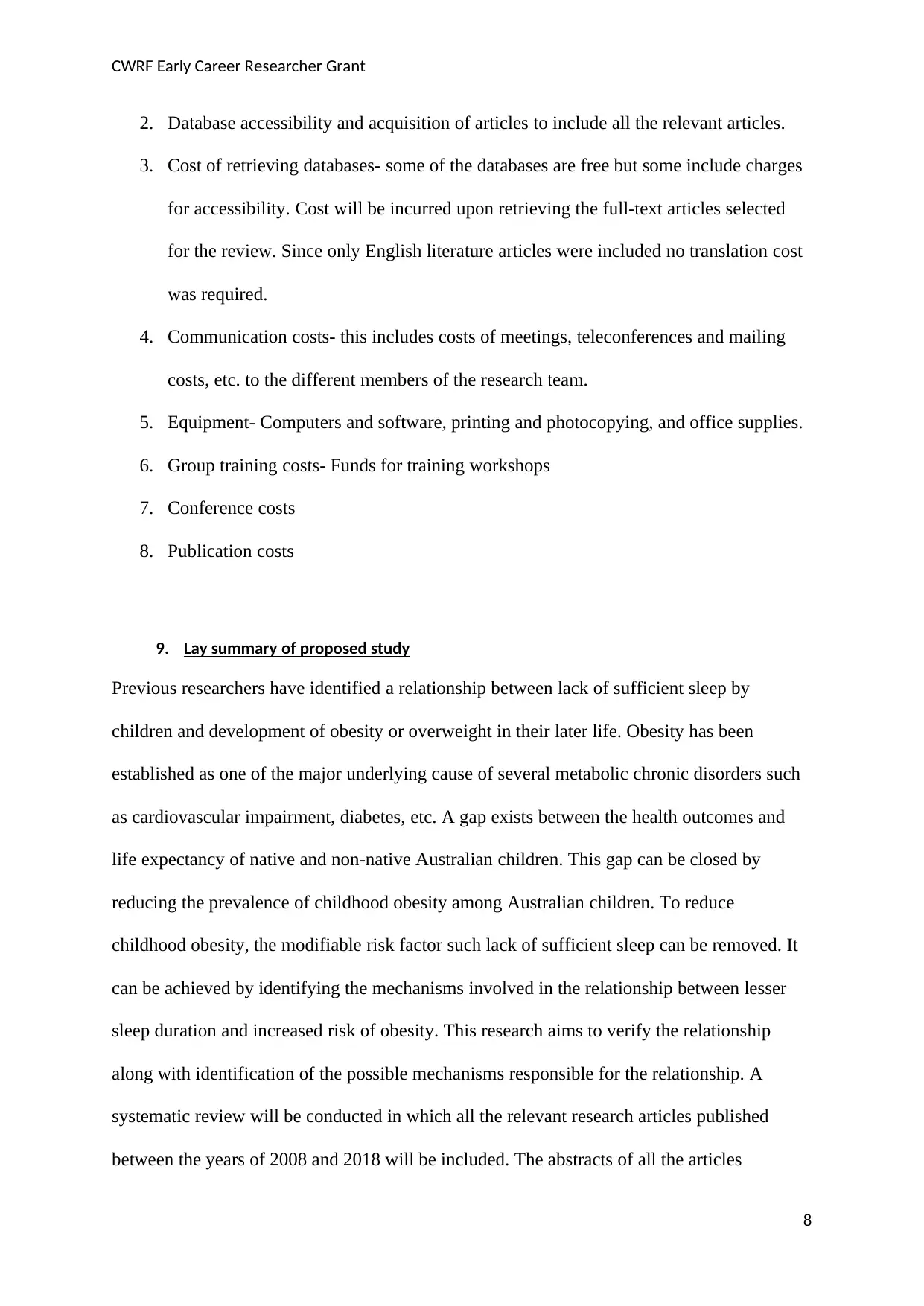
CWRF Early Career Researcher Grant
2. Database accessibility and acquisition of articles to include all the relevant articles.
3. Cost of retrieving databases- some of the databases are free but some include charges
for accessibility. Cost will be incurred upon retrieving the full-text articles selected
for the review. Since only English literature articles were included no translation cost
was required.
4. Communication costs- this includes costs of meetings, teleconferences and mailing
costs, etc. to the different members of the research team.
5. Equipment- Computers and software, printing and photocopying, and office supplies.
6. Group training costs- Funds for training workshops
7. Conference costs
8. Publication costs
9. Lay summary of proposed study
Previous researchers have identified a relationship between lack of sufficient sleep by
children and development of obesity or overweight in their later life. Obesity has been
established as one of the major underlying cause of several metabolic chronic disorders such
as cardiovascular impairment, diabetes, etc. A gap exists between the health outcomes and
life expectancy of native and non-native Australian children. This gap can be closed by
reducing the prevalence of childhood obesity among Australian children. To reduce
childhood obesity, the modifiable risk factor such lack of sufficient sleep can be removed. It
can be achieved by identifying the mechanisms involved in the relationship between lesser
sleep duration and increased risk of obesity. This research aims to verify the relationship
along with identification of the possible mechanisms responsible for the relationship. A
systematic review will be conducted in which all the relevant research articles published
between the years of 2008 and 2018 will be included. The abstracts of all the articles
8
2. Database accessibility and acquisition of articles to include all the relevant articles.
3. Cost of retrieving databases- some of the databases are free but some include charges
for accessibility. Cost will be incurred upon retrieving the full-text articles selected
for the review. Since only English literature articles were included no translation cost
was required.
4. Communication costs- this includes costs of meetings, teleconferences and mailing
costs, etc. to the different members of the research team.
5. Equipment- Computers and software, printing and photocopying, and office supplies.
6. Group training costs- Funds for training workshops
7. Conference costs
8. Publication costs
9. Lay summary of proposed study
Previous researchers have identified a relationship between lack of sufficient sleep by
children and development of obesity or overweight in their later life. Obesity has been
established as one of the major underlying cause of several metabolic chronic disorders such
as cardiovascular impairment, diabetes, etc. A gap exists between the health outcomes and
life expectancy of native and non-native Australian children. This gap can be closed by
reducing the prevalence of childhood obesity among Australian children. To reduce
childhood obesity, the modifiable risk factor such lack of sufficient sleep can be removed. It
can be achieved by identifying the mechanisms involved in the relationship between lesser
sleep duration and increased risk of obesity. This research aims to verify the relationship
along with identification of the possible mechanisms responsible for the relationship. A
systematic review will be conducted in which all the relevant research articles published
between the years of 2008 and 2018 will be included. The abstracts of all the articles
8
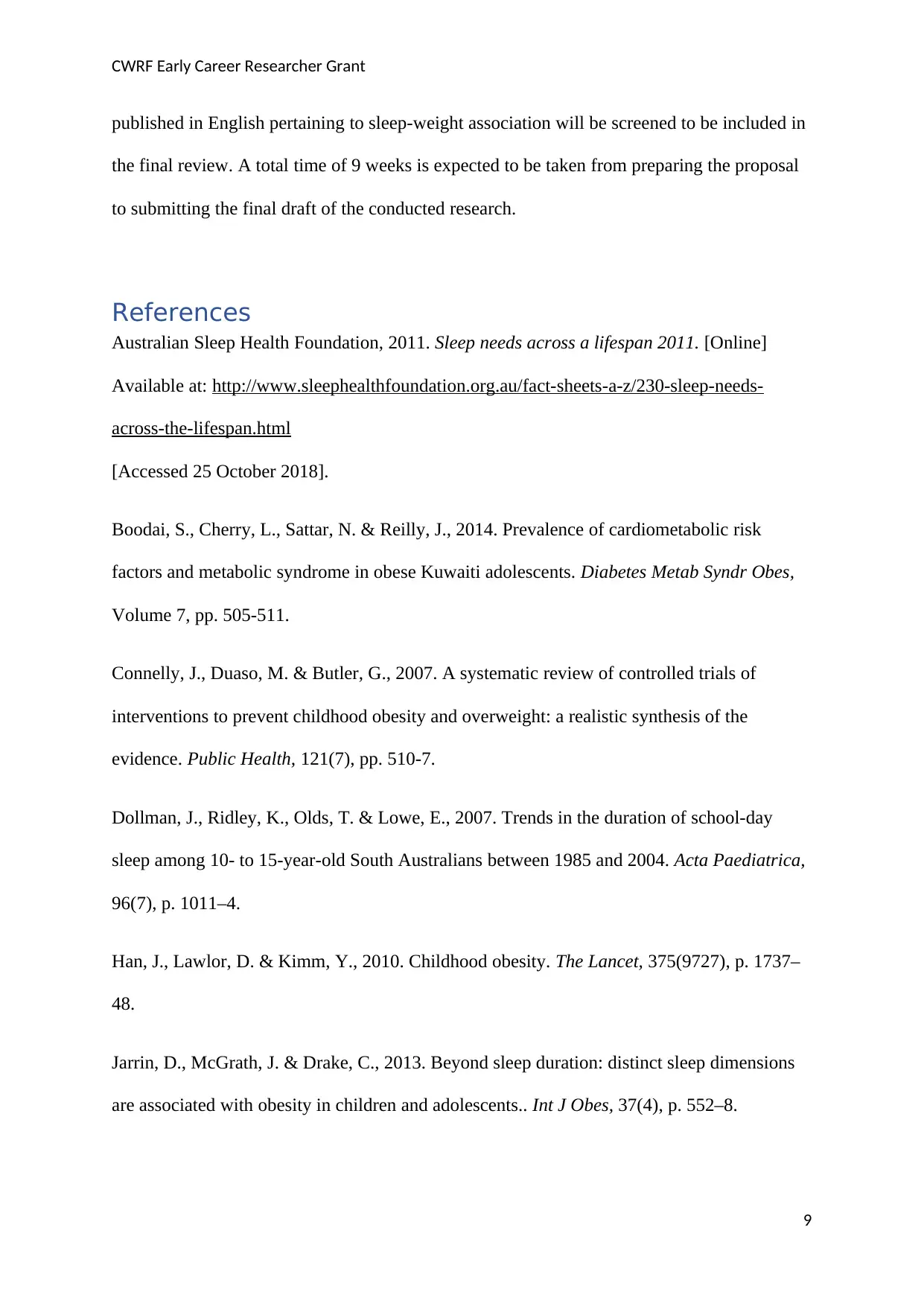
CWRF Early Career Researcher Grant
published in English pertaining to sleep-weight association will be screened to be included in
the final review. A total time of 9 weeks is expected to be taken from preparing the proposal
to submitting the final draft of the conducted research.
References
Australian Sleep Health Foundation, 2011. Sleep needs across a lifespan 2011. [Online]
Available at: http://www.sleephealthfoundation.org.au/fact-sheets-a-z/230-sleep-needs-
across-the-lifespan.html
[Accessed 25 October 2018].
Boodai, S., Cherry, L., Sattar, N. & Reilly, J., 2014. Prevalence of cardiometabolic risk
factors and metabolic syndrome in obese Kuwaiti adolescents. Diabetes Metab Syndr Obes,
Volume 7, pp. 505-511.
Connelly, J., Duaso, M. & Butler, G., 2007. A systematic review of controlled trials of
interventions to prevent childhood obesity and overweight: a realistic synthesis of the
evidence. Public Health, 121(7), pp. 510-7.
Dollman, J., Ridley, K., Olds, T. & Lowe, E., 2007. Trends in the duration of school-day
sleep among 10- to 15-year-old South Australians between 1985 and 2004. Acta Paediatrica,
96(7), p. 1011–4.
Han, J., Lawlor, D. & Kimm, Y., 2010. Childhood obesity. The Lancet, 375(9727), p. 1737–
48.
Jarrin, D., McGrath, J. & Drake, C., 2013. Beyond sleep duration: distinct sleep dimensions
are associated with obesity in children and adolescents.. Int J Obes, 37(4), p. 552–8.
9
published in English pertaining to sleep-weight association will be screened to be included in
the final review. A total time of 9 weeks is expected to be taken from preparing the proposal
to submitting the final draft of the conducted research.
References
Australian Sleep Health Foundation, 2011. Sleep needs across a lifespan 2011. [Online]
Available at: http://www.sleephealthfoundation.org.au/fact-sheets-a-z/230-sleep-needs-
across-the-lifespan.html
[Accessed 25 October 2018].
Boodai, S., Cherry, L., Sattar, N. & Reilly, J., 2014. Prevalence of cardiometabolic risk
factors and metabolic syndrome in obese Kuwaiti adolescents. Diabetes Metab Syndr Obes,
Volume 7, pp. 505-511.
Connelly, J., Duaso, M. & Butler, G., 2007. A systematic review of controlled trials of
interventions to prevent childhood obesity and overweight: a realistic synthesis of the
evidence. Public Health, 121(7), pp. 510-7.
Dollman, J., Ridley, K., Olds, T. & Lowe, E., 2007. Trends in the duration of school-day
sleep among 10- to 15-year-old South Australians between 1985 and 2004. Acta Paediatrica,
96(7), p. 1011–4.
Han, J., Lawlor, D. & Kimm, Y., 2010. Childhood obesity. The Lancet, 375(9727), p. 1737–
48.
Jarrin, D., McGrath, J. & Drake, C., 2013. Beyond sleep duration: distinct sleep dimensions
are associated with obesity in children and adolescents.. Int J Obes, 37(4), p. 552–8.
9
⊘ This is a preview!⊘
Do you want full access?
Subscribe today to unlock all pages.

Trusted by 1+ million students worldwide
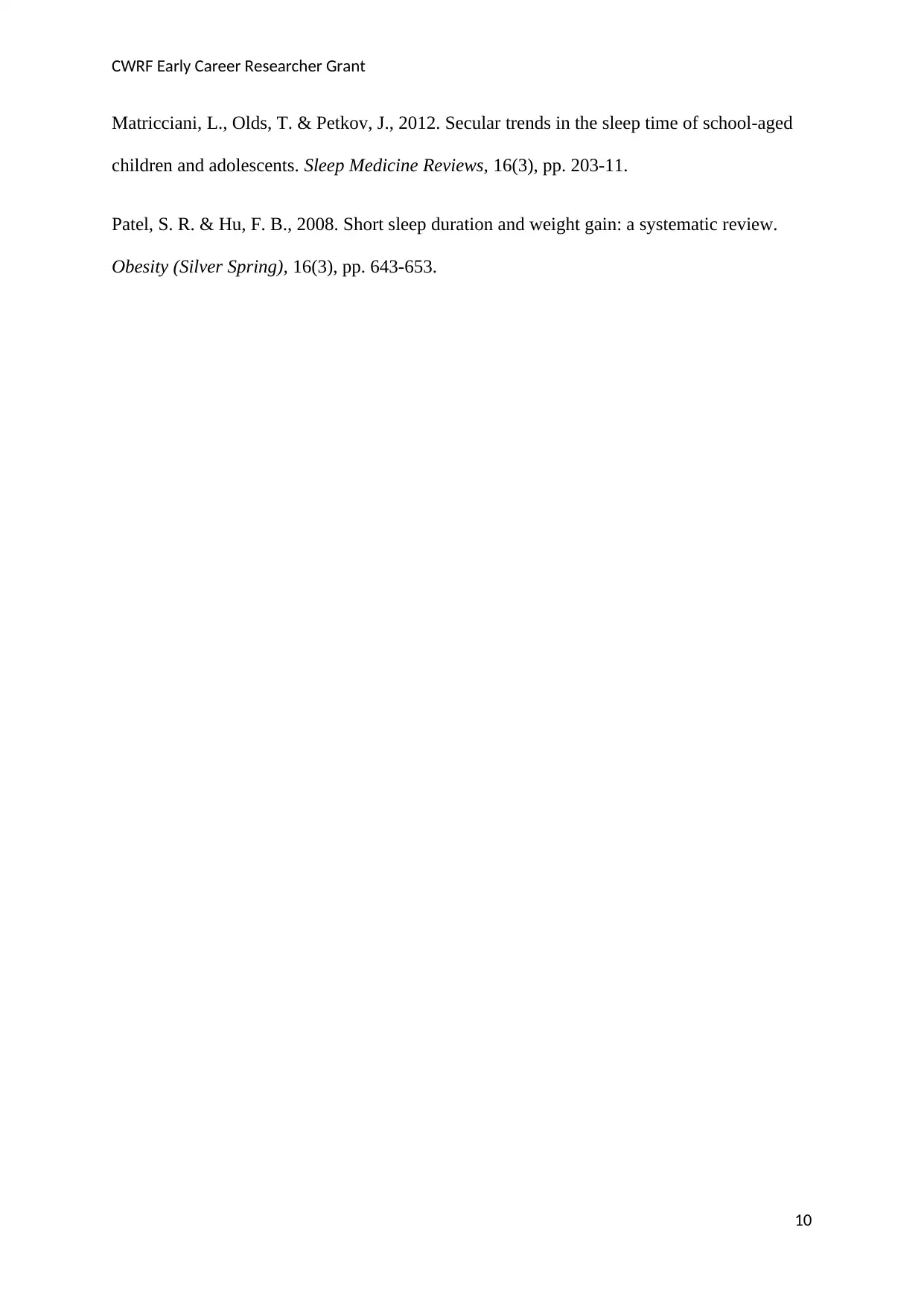
CWRF Early Career Researcher Grant
Matricciani, L., Olds, T. & Petkov, J., 2012. Secular trends in the sleep time of school-aged
children and adolescents. Sleep Medicine Reviews, 16(3), pp. 203-11.
Patel, S. R. & Hu, F. B., 2008. Short sleep duration and weight gain: a systematic review.
Obesity (Silver Spring), 16(3), pp. 643-653.
10
Matricciani, L., Olds, T. & Petkov, J., 2012. Secular trends in the sleep time of school-aged
children and adolescents. Sleep Medicine Reviews, 16(3), pp. 203-11.
Patel, S. R. & Hu, F. B., 2008. Short sleep duration and weight gain: a systematic review.
Obesity (Silver Spring), 16(3), pp. 643-653.
10
1 out of 10
Related Documents
Your All-in-One AI-Powered Toolkit for Academic Success.
+13062052269
info@desklib.com
Available 24*7 on WhatsApp / Email
![[object Object]](/_next/static/media/star-bottom.7253800d.svg)
Unlock your academic potential
Copyright © 2020–2025 A2Z Services. All Rights Reserved. Developed and managed by ZUCOL.





